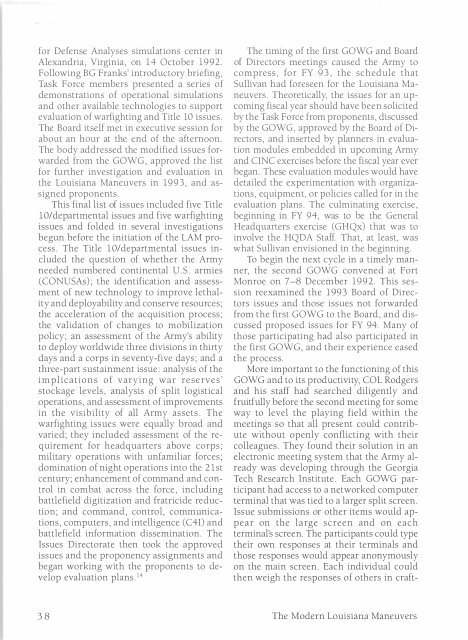The Modern Louisiana Maneuvers - US Army Center Of Military History
The Modern Louisiana Maneuvers - US Army Center Of Military History
The Modern Louisiana Maneuvers - US Army Center Of Military History
Create successful ePaper yourself
Turn your PDF publications into a flip-book with our unique Google optimized e-Paper software.
for Defense Analyses simulations center in<br />
Alexandria, Virginia, on 14 October 1992.<br />
Following BG Franks' introductory briefing,<br />
Task Force members presented a series of<br />
demonstrations of operational simulations<br />
and other available technologies to support<br />
evaluation of warfighting and Title 10 issues.<br />
<strong>The</strong> Board itself met in executive session for<br />
about an hour at the end of the afternoon.<br />
<strong>The</strong> body addressed the modified issues forwarded<br />
from the GOWG, approved the list<br />
for further investigation and evaluation in<br />
the <strong>Louisiana</strong> <strong>Maneuvers</strong> in 1993, and assigned<br />
proponents.<br />
This final list of issues included five Title<br />
10/departmental issues and five warfighting<br />
issues and folded in several investigations<br />
begun before the initiation of the LAM process.<br />
<strong>The</strong> Title 10/departmental issues included<br />
the question of whether the <strong>Army</strong><br />
needed numbered continental U.S. armies<br />
(CON<strong>US</strong>As) ; the identification and assessment<br />
of new technology to improve lethality<br />
and deployability and conserve resources;<br />
the acceleration of the acquisition process;<br />
the validation of changes to mobilization<br />
policy; an assessment of the <strong>Army</strong>'s ability<br />
to deploy worldwide three divisions in thirty<br />
days and a corps in seventy-five days; and a<br />
three-part sustainment issue: analysis of the<br />
implications of varying war reserves'<br />
stockage levels, analysis of split logistical<br />
operations, and assessment of improvements<br />
in the visibility of all <strong>Army</strong> assets. <strong>The</strong><br />
warfighting issues were equally broad and<br />
varied; they included assessment of the requirement<br />
for headquarters above corps;<br />
military operations with unfamiliar forces;<br />
domination of night operations into the 21st<br />
century; enhancement of command and control<br />
in combat across the force, including<br />
battlefield digitization and fratricide reduction;<br />
and command, control, communications,<br />
computers, and intelligence (C4I) and<br />
battlefield information dissemination. <strong>The</strong><br />
Issues Directorate then took the approved<br />
issues and the proponency assignments and<br />
began working with the proponents to develop<br />
evaluation plans. 14<br />
38<br />
<strong>The</strong> timing of the first GOWG and Board<br />
of Directors meetings caused the <strong>Army</strong> to<br />
compress, for FY 93, the schedule that<br />
Sullivan had foreseen for the <strong>Louisiana</strong> <strong>Maneuvers</strong>.<br />
<strong>The</strong>oretically, the issues for an upcoming<br />
fiscal year should have been solicited<br />
by the Task Force from proponents, discussed<br />
by the GOWG, approved by the Board of Directors<br />
, and inserted by planners in evaluation<br />
modules embedded in upcoming <strong>Army</strong><br />
and CINC exercises before the fiscal year ever<br />
began. <strong>The</strong>se evaluation modules would have<br />
detailed the experimentation with organizations,<br />
equipment, or policies called for in the<br />
evaluation plans. <strong>The</strong> culminating exercise,<br />
beginning in FY 94, was to be the General<br />
Headquarters exercise (GHQx) that was to<br />
involve the HQDA Staff. That, at least, was<br />
what Sullivan envisioned in the beginning.<br />
To begin the next cycle in a timely manner,<br />
the second GOWG convened at Fort<br />
Monroe on 7-8 December 1992. This session<br />
reexamined the 1993 Board of Directors<br />
issues and those issues not forwarded<br />
from the first GOWG to the Board, and discussed<br />
proposed issues for FY 94. Many of<br />
those participating had also participated in<br />
the first GOWG, and their experience eased<br />
the process.<br />
More important to the functioning of this<br />
GOWG and to its productivity, COL Rodgers<br />
and his staff had searched diligently and<br />
fruitfully before the second meeting for some<br />
way to level the playing field within the<br />
meetings so that all present could contribute<br />
without openly conflicting with their<br />
colleagues. <strong>The</strong>y found their solution in an<br />
electronic meeting system that the <strong>Army</strong> already<br />
was developing through the Georgia<br />
Tech Research Institute. Each GOWG participant<br />
had access to a networked computer<br />
terminal that was tied to a larger split screen.<br />
Issue submissions or either items would appear<br />
on the large screen and on each<br />
terminal's screen. <strong>The</strong> participants could type<br />
their own responses at their terminals and<br />
those responses would appear anonymously<br />
on the main screen. Each individual could<br />
then weigh the responses of others in craft-<br />
<strong>The</strong> <strong>Modern</strong> <strong>Louisiana</strong> <strong>Maneuvers</strong>
















